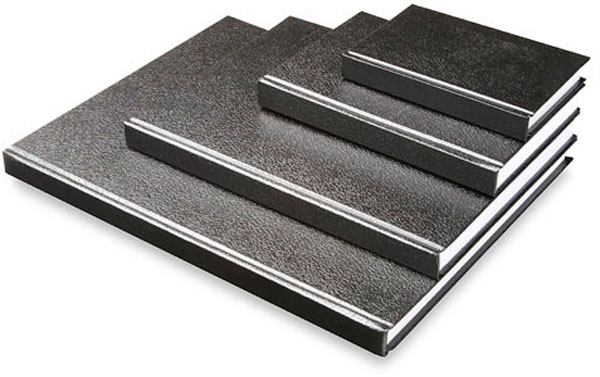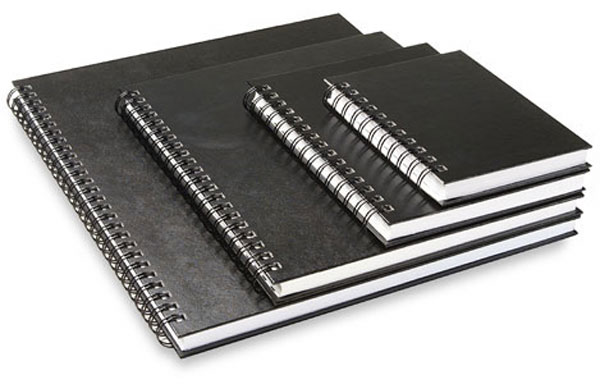Basic Bound Journal
This is probably the most obvious choice for beginners, a basic bound sketchbook.
- Pros
- Large variety of sizes
- Easily accessible (available at many stores)
- Large variety of paper weights
- Cons
- Blank Pages (can cause the "I don't want to ruin it" effect, or the "where to start" effect)
- Some can be difficult to open flat
- My Two Cents
- This is a great easy choice for an art journal. The wide selection of papers and manufacturers will almost ensure that you can find something that you like and fits your needs. If blank pages are an issue, try a process of "unblanking the pages," such as creating watercolor washes on all the pages prior to starting the art journal. Moleskine is my favorite of this category, as it has a closure to hold the book safely closed, and pockets to hold ephemera.
Basic Spiral Journal

- Pros
- Large variety of sizes
- Easily accessible (available at many stores)
- Large variety of paper weights
- Will easily lay flat
- Cons
- Blank Pages (can cause the "I don't want to ruin it" effect, or the "where to start" effect)
- The spiral can be difficult to work with when creating two-page spreads
- My Two Cents
- This is also a great choice for art journalers. Some artists love the ability to lay the journal flat. However since I almost always work in spreads, I do not like the spiral in the middle. Again, if blank pages are an issue, try a process of "unblanking the pages," such as creating watercolor washes on all the pages prior to starting the art journal. Strathmore has recently launched a "Visual Journal" line that are spiral bound art journals.
Loose Pages as a Journal

- Pros
- Infinite variety of sizes, and shapes
- Probably have loose pages on hand
- Can discard pages if you mess up
- Can pre-arrange pages
- Cons
- Some pages may get displaces, or lost accidentally
- No closure (read more about that here)
- Can discard pages if you mess up (read more about that here)
- My Two Cents
- For me the idea of the journal is imperative, as it keeps the imagery and ideas safe and contained. However, journaling on loose pages may be less threatening as there is nothing to fill, just one page at a time. Chris and I chose a deck of cards for our first journal together, and it was a very successful journal for us, however in the end, review of the journal became difficult as did storage.
Altered Book

- Pros
- Cheap (we often buy books at Goodwill for 25¢, but could also get free)
- Recycling (I see this as a green alternative to buying new)
- No blank-page effect (working on pages with stuff already on them may not be as overwhelming)
- Metaphor of transformation (taking something discarded and making it a work of art)
- Cons
- Pages are not made to create art on (paper quality and thickness may not be appropriate for artmaking)
- May require some preparation time (gessoing pages, gluing pages together for added thickness)
- My Two Cents
- This is one of my favorite types of art journals. I love the metaphor of transformation, as I believe that art journaling is a transformative process. Additionally there are infinite varieties of books out there to alter. Children's books are often short and have few pages, and so are great for a defined theme, or as a beginning journal as the limited pages make it easy to finish and not as overwhelming. (Read more about altering board books here.) Larger books, such as atlases, are also great for journals. Since my style has evolved to a very mixed-media style, I also like being able to show some of the original book pages in my artwork.
Hand-bound Journal
- Pros
- Control of the paper
- Control of size
- An artform in itself
- Variety of binding techniques
- Supports other artists (if buying from someone)
- Cons
- Require some, if not lots of, preparation time (if you are binding)
- Learning curve (there is a learning curve, as with all new skills, and your first binding may not be as strong as you would like)
- My Two Cents
- This is also one of my favorite options, as I like the idea of book-making. This category has so many variations, however, that it is difficult to list all the pros and cons. I personally like to bind my books out of discarded materials, making it a transformative process, for example. But many artists will choose high quality artists papers to bind their books, which can also be very fulfilling but causes "the blank page effect." If you decide to bind your own book there are many books out there (this one is my favorite). I will warn you that it can become addictive! But it is so rewarding to have your art journal be created by you from the start to finish!



I'd much rather recommend to make your own -recycled journal - that in itself is a very crafty and heart-felt task and ... it's good for the environment --- I made mine from notebook and sketchbook remnants and wallpaper scraps ... cuttings from old magazines and some glitzy stuff from left-over card-crafting ... so my journal is a truly unique and earth-friendly statement :D
ReplyDeleteReally cool iris! Could you post a picture of it? I want to make one someday and I'd like some pictures for inspiration. Thanks!! :)
DeleteWonderful post!
ReplyDeleteWell-written and great for every artist to read and re-read!
Thank you, too, for joining my art blog hop~
I enjoy following your blog very much. :)
All the best,
Mary
Thanks ladies!
ReplyDeleteIris I agree... I make a lot of my own journals as well.